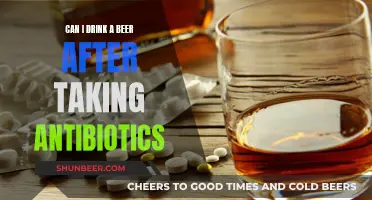
Beer and food have gone hand in hand since the invention of brewing. While some foods don't go well with alcohol, beer can complement a meal, and vice versa. The bitterness of beer is often balanced out by the greasiness or saltiness of a carb-heavy meal, for example. Beer also has nutritional benefits, containing B vitamins, phosphorus, folate, niacin, protein, and fibre. However, it's important to be mindful of the number of calories in beer, and drinking on an empty stomach is not recommended due to the increased speed of alcohol absorption.
| Characteristics | Values |
|---|---|
| Enjoyment | Beer and food can add to the enjoyment of each other |
| Alcohol content | Beer is less alcoholic than wine |
| Thirst quenching | Beer is better than wine at quenching thirst |
| Food pairing | Beer goes better with some foods than wine |
| Creativity | There are many types of beer, allowing for creative combinations |
| Focus | The choice of beer depends on whether the focus is on drinking with friends or enjoying a gourmet dinner |
| Weather | The choice of beer depends on the weather |
| Spiciness | The choice of beer depends on how spicy the food is |
| Acidity | The choice of beer depends on the acidity of the food |
| Flavour strength | The choice of beer depends on the strength of the food's flavours |
| Health | Drinking beer in moderation can have positive effects for your heart, bones, blood sugars, and dementia risk |
| Health | Drinking beer in excess raises your risk of many health issues, including depression, weight gain, and liver disease |
What You'll Learn

Beer and food can complement each other
When it comes to complementary pairings, look for similarities in aromas and flavours between the beer and the dish. For instance, a Belgian Witbier, brewed with coriander, pairs well with a dish that has a coriander spice note. Similarly, a funky-smelling sour beer, such as a Gueuze, complements a cheese with a pleasant funky aroma. This approach creates a harmonious dining experience where the flavours of the beer and food enhance each other.
Barbecue ribs, with their caramelised and charred outer edges, are a classic example of a dish that pairs perfectly with a robust porter or a German Rauchbier. The deep, chocolaty roasted character of the malts in these beers complements the flavours of the barbecue ribs. For an extra special treat, try pairing the ribs with a Chocolate Maple Porter, taking the complementary flavours to the next level.
If you're looking for a lighter option, a Waldorf salad pairs beautifully with a hoppy beer. The citrus, tropical, and stone fruit flavours of the beer complement the apples and grapes in the salad, while the biscuity malt base of the beer matches the earthier walnuts. Wheat beers are also a great choice for seafood, especially mussels. The estery, clovey flavours of the wheat beer combine perfectly with the fragrance of the mussels, creating a delightful sensory experience.
So, the next time you're planning a meal or perusing a menu, consider the complementary flavours of beer and food. With the right pairings, you can elevate your dining experience and discover new taste sensations.
Beer and Antibiotics: A Dangerous Mix?
You may want to see also

Beer is less alcoholic than wine
When it comes to alcohol content, beer is less strong than wine. A pint of lager and a medium glass of wine contain roughly the same amount of alcohol – two or three UK units (16-24g). However, the speed at which alcohol enters the bloodstream depends on the type of drink. Spirits enter the bloodstream the quickest, followed by wine, and then beer. So, a glass of wine will get you drunk faster than a pint of beer.
The alcohol content of wine is usually higher than that of beer. Most wines have an ABV of about 12%, while regular beer starts at around 5% ABV. Heavier craft beers or barrel-aged beers can have a similar ABV to wine.
While beer may be less alcoholic than wine, it is important to note that the more you drink, the more health benefits diminish. Heavy drinking has been linked to higher rates of obesity. Additionally, excessive drinking can negatively impact your health, including affecting your sleep, raising your risk of various cancers, and increasing your risk of cardiovascular disease and dependency. Therefore, it is crucial to consume alcohol in moderation, regardless of whether you choose beer or wine.
Dialysis and Alcohol: Is Beer Safe for Dialysis Patients?
You may want to see also

Beer is better than wine at quenching thirst
Firstly, beer is more like a food than a beverage, often referred to as "liquid bread". It contains nutrients such as protein, B vitamins, phosphorus, folate, niacin, and fibre. Beer also has a higher antioxidant content than wine, although the specific antioxidants are different due to the use of barley and hops in beer production, as opposed to grapes in wine.
Secondly, beer has a high water content, typically ranging from 90-95%. This high water content can temporarily satisfy thirst, especially after strenuous activity. Lighter-bodied, low ABV beers are particularly good at quenching thirst, whereas heavier beers can leave you feeling weighed down. In fact, some studies have shown that very low ABV beers (2% or lower) can hydrate better than water under specific conditions, especially when combined with sodium, as this helps to reduce urine output.
When comparing the effects of beer and wine on urine output, one study found that stronger alcoholic drinks, such as wine, have a short-term diuretic effect, whereas the urine output after drinking a typical beer was no different from that of a non-alcoholic beer or water. Therefore, beer is less likely to leave you feeling dehydrated than wine.
So, if you're looking for a drink to quench your thirst, beer is a better choice than wine, especially if you opt for a low ABV variety.
Shrooms, Weed, and Beer: A Harmful Cocktail?
You may want to see also

Beer before a meal can get you drunk faster
Beer is often enjoyed with food, but drinking it before a meal can have different effects on the body than drinking it on a full stomach. Alcohol is absorbed into the bloodstream through the stomach, so drinking on an empty stomach means it will affect you faster.
When you drink on an empty stomach, alcohol passes quickly from the stomach into the small intestine, where it is mostly absorbed into the bloodstream. This intensifies the side effects of drinking, such as impaired thinking and coordination. The body absorbs alcohol more slowly when there is food in the stomach, which can help to prevent these negative effects.
Drinking beer before a meal can be dangerous, especially in large quantities. An inability to think clearly or move safely could lead to injury or death in extreme cases. It can also take a toll on your liver, kidneys, cardiovascular system, and digestive tract.
To avoid the negative effects of drinking on an empty stomach, it is recommended to eat at least an hour before drinking if you plan on consuming more than one drink. It is also important to know your limits and not drink more than one standard drink per hour.
Drinking and Driving: Is it Safe to Drive After Beers?
You may want to see also

Beer after a meal can make you nauseous
There are several reasons why drinking beer after a meal can make you nauseous. Firstly, it is important to understand that beer contains ingredients that can trigger sensitivities or intolerances in some individuals. These ingredients include grains, modified grain proteins, hops, yeast, moulds, barleys, and additives such as sulphites, sodium benzoate, or tartrazine. If you have a sensitivity or intolerance to any of these ingredients, consuming beer after a meal can lead to digestive issues, including nausea.
Another reason for nausea after drinking beer with a meal could be related to the body's preferred order of digestion. The body tends to prioritise the digestion of alcohol over other macronutrients. When beer is consumed with a meal, the liver may become overwhelmed, especially if the meal contains yeast, which is also present in beer. This can result in digestive issues, bloating, and the body's attempt to get rid of toxins.
Additionally, the combination of beer and certain foods can be problematic. For example, pairing beer with bread can lead to dehydration because both contain high amounts of yeast. This can further disrupt the digestion process and contribute to nausea. Similarly, consuming beer with dairy products can lead to infections, stomach pain, and constipation. Spicy foods, when combined with beer, can also cause digestive issues and acid reflux.
Furthermore, drinking beer after a meal can lead to nausea if it results in alcohol intolerance or an allergic reaction. Alcohol intolerance can cause negative symptoms such as nausea, even from small amounts of alcohol. This occurs when the body struggles to break down alcohol effectively, leading to the production of acetaldehyde, a harmful chemical. Acetaldehyde is responsible for uncomfortable symptoms such as nausea and headaches.
To minimise the risk of nausea after drinking beer with a meal, it is advisable to be mindful of the ingredients and food combinations that may trigger sensitivities or intolerances. It is also crucial to consume alcohol in moderation and ensure proper hydration to support the body's digestion and toxin elimination processes.
Mixing Beer and Tylenol: Is it Safe?
You may want to see also
Frequently asked questions
Drinking beer with food is a matter of personal preference. Beer and food can complement each other well when chosen carefully. Beer is less alcoholic than wine and therefore better at quenching thirst. However, it is important to drink in moderation and be mindful of health conditions and how alcohol may affect them.
The choice of beer depends on the type of food served in terms of acidity, strength of flavours, and spiciness. For instance, a lighter beer with hoppy notes is recommended for fish and chips.
Drinking one or two standard beers per day may have positive effects on your heart, bones, blood sugar, and dementia risk. Beer also contains some nutrients, such as B vitamins, phosphorus, folate, and niacin.







